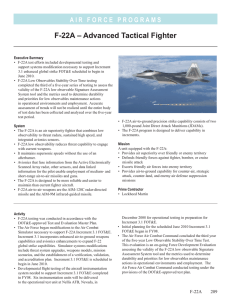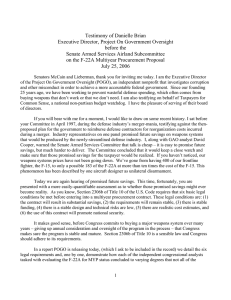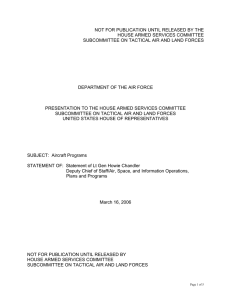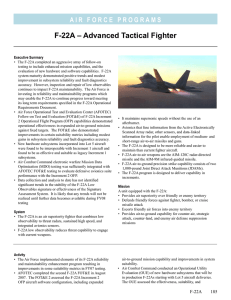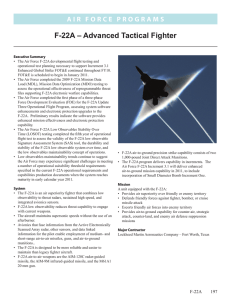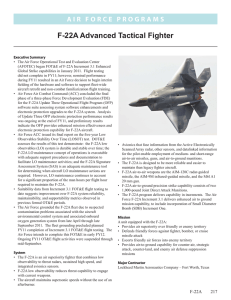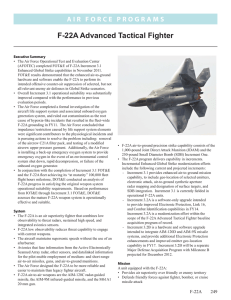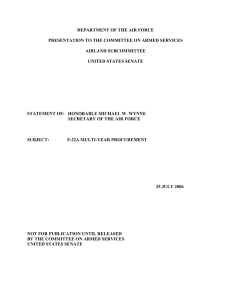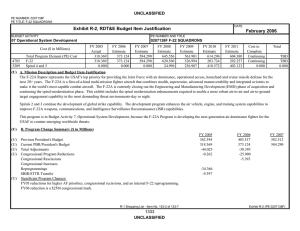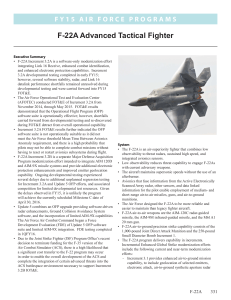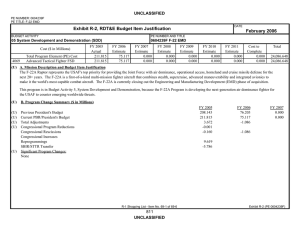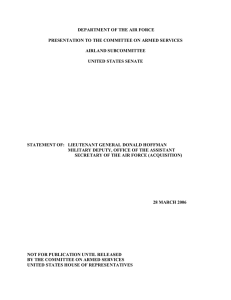F-22A – Advanced Tactical Fighter
advertisement
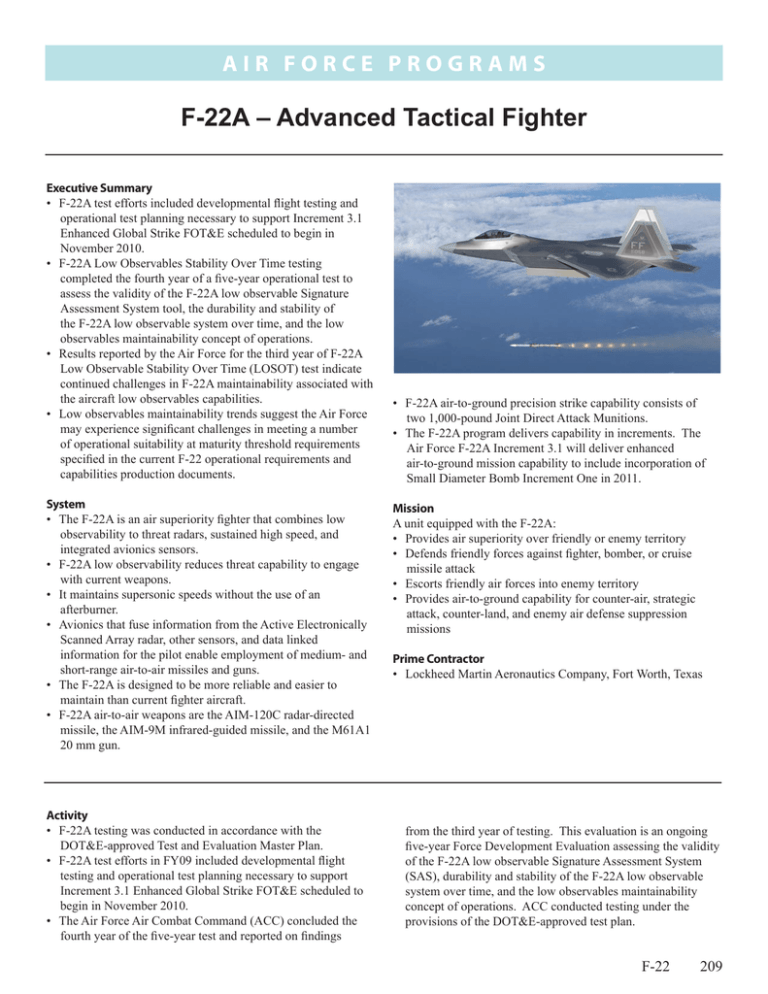
AIR FOR C E P ROGRA M S F-22A – Advanced Tactical Fighter Executive Summary • F-22A test efforts included developmental flight testing and operational test planning necessary to support Increment 3.1 Enhanced Global Strike FOT&E scheduled to begin in November 2010. • F-22A Low Observables Stability Over Time testing completed the fourth year of a five-year operational test to assess the validity of the F-22A low observable Signature Assessment System tool, the durability and stability of the F-22A low observable system over time, and the low observables maintainability concept of operations. • Results reported by the Air Force for the third year of F-22A Low Observable Stability Over Time (LOSOT) test indicate continued challenges in F-22A maintainability associated with the aircraft low observables capabilities. • Low observables maintainability trends suggest the Air Force may experience significant challenges in meeting a number of operational suitability at maturity threshold requirements specified in the current F-22 operational requirements and capabilities production documents. System • The F-22A is an air superiority fighter that combines low observability to threat radars, sustained high speed, and integrated avionics sensors. • F-22A low observability reduces threat capability to engage with current weapons. • It maintains supersonic speeds without the use of an afterburner. • Avionics that fuse information from the Active Electronically Scanned Array radar, other sensors, and data linked information for the pilot enable employment of medium- and short-range air-to-air missiles and guns. • The F-22A is designed to be more reliable and easier to maintain than current fighter aircraft. • F-22A air-to-air weapons are the AIM-120C radar-directed missile, the AIM-9M infrared-guided missile, and the M61A1 20 mm gun. Activity • F-22A testing was conducted in accordance with the DOT&E‑approved Test and Evaluation Master Plan. • F-22A test efforts in FY09 included developmental flight testing and operational test planning necessary to support Increment 3.1 Enhanced Global Strike FOT&E scheduled to begin in November 2010. • The Air Force Air Combat Command (ACC) concluded the fourth year of the five-year test and reported on findings • F-22A air-to-ground precision strike capability consists of two 1,000-pound Joint Direct Attack Munitions. • The F-22A program delivers capability in increments. The Air Force F-22A Increment 3.1 will deliver enhanced air‑to‑ground mission capability to include incorporation of Small Diameter Bomb Increment One in 2011. Mission A unit equipped with the F-22A: • Provides air superiority over friendly or enemy territory • Defends friendly forces against fighter, bomber, or cruise missile attack • Escorts friendly air forces into enemy territory • Provides air-to-ground capability for counter-air, strategic attack, counter-land, and enemy air defense suppression missions Prime Contractor • Lockheed Martin Aeronautics Company, Fort Worth, Texas from the third year of testing. This evaluation is an ongoing five-year Force Development Evaluation assessing the validity of the F-22A low observable Signature Assessment System (SAS), durability and stability of the F-22A low observable system over time, and the low observables maintainability concept of operations. ACC conducted testing under the provisions of the DOT&E-approved test plan. F-22 209 AIR FOR C E P ROGRA M S Assessment • The program is progressing to meet planned Increment 3.1 FOT&E scheduled for November 2010 through May 2011. • In FY07 DOT&E assessed that inspection and repair of low observables had a considerable impact on F-22A maintainability. FY07 test results demonstrated that maintaining the low observable signature required a significant level of F-22A maintenance effort. These FY07 test results further indicated that restoration of the low observable signature required long durations to cure materials often resulting in extended periods of time during which aircraft are not available for operational missions. • Though a complete assessment of trends will not be realized until the entire body of LOSOT test data is collected and analyzed, ACC reporting of third year interim findings indicate ongoing challenges in F-22A low observables maintainability. ACC interim findings noted: ­- The F-22A SAS appears to be adequate for low observables maintenance documentation. However, SAS accuracy is dependent upon the expertise and accuracy of individual maintenance personnel in documenting signature discrepancies and inputting data into the automated system. ­- The current SAS software and hardware should be upgraded to speed data entry procedures and decrease system processing time to increase productivity. ­- Maintaining SAS data integrity requires regular audits and database checks performed by experienced low observables maintenance personnel. ­- Continuation training for low observables maintenance personnel is required for the proper documentation of aircraft damage discrepancies, recognition of differences between similar types of low observables damages, and 210 F-22 identification of correct logistical control numbers when using SAS. ­- LOSOT testing should be continued after completion of the current five year test in FOT&E to include F-22A Block 30 aircraft. • DOT&E agrees with the ACC FY09 F-22A LOSOT interim findings. The findings are consistent with F-22 operational fleet trends and DOT&E FY07 observations. Low observables maintainability is an ongoing challenge and continues to account for a significant proportion of the man hours per flight hour required to maintain the F-22. This impacts both aircraft operational availability and mission capable rates. • The F-22A will reach 100,000 fleet flight hour system maturity in the 2010 to 2011 time period. Given the maintainability metrics achieved in operational testing to date, the Air Force may experience significant challenges in meeting a number of at maturity operational suitability thresholds specified in the current F-22 operational requirements and capabilities production documents. Recommendations • Status of Previous Recommendations. The Air Force continues to address all previous recommendations. • FY09 Recommendation. 1. The Air Force should plan to conduct further follow-on test and evaluation of F-22A low observables capabilities after the completion of the current five-year LOSOT test to continue to assess the validity of the F-22A low observable SAS, durability and stability of the F-22A low observable system over time, and to assess the low observables maintainability concept of operations.
